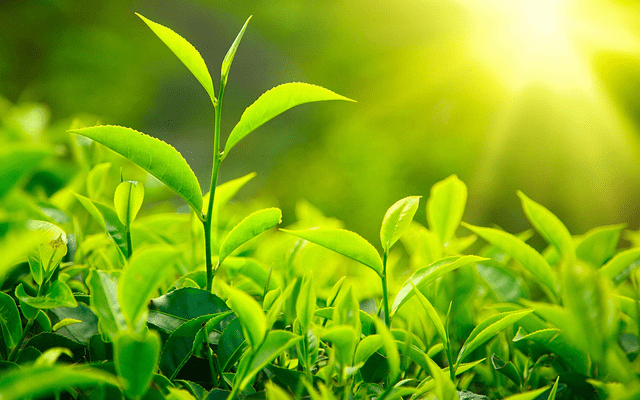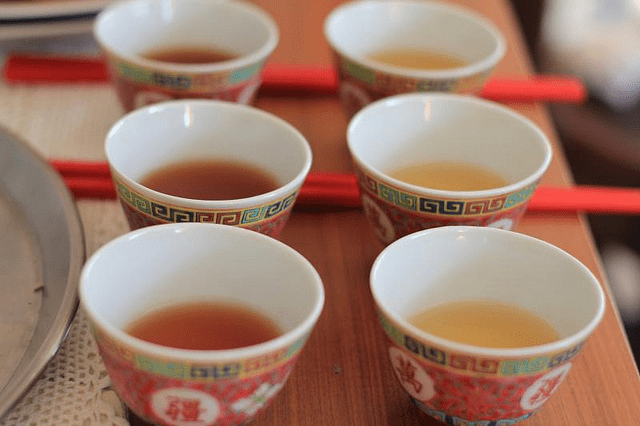I'm a tea person. This is pretty controversial in the land of good ol' hard-workin', coffee-drinkin' Americans, but I suspect there are a few of you who prefer leaf water over bean water, too. One thing that I love about tea is that there are so many different varieties. White, green, black, oolong -there's a tea for any occasion! If you're an avid tea drinker like me, I'm sure you know that these four are the most popular, but did you know that all these teas come from the same plant?
Camellia sinensis is a shrub that produces the leaves in white tea, green tea, black tea, and oolong tea. What makes these teas distinct is how the processor treats the leaves after they're harvested. By following a specific sequence of steps, a tea processor can transform his ordinary Camellia sinensis leaves into any delicious tea brew he desires!

Black/Oolong Tea
If you live in the South, you know what black tea is. You know, it's the liquid accompanying all that sugar in your sweet tea? Black tea is the most commonly consumed form of tea in the world, and it unarguably has the boldest taste. To achieve this flavor, a processor will follow 4 steps to process his leaves:
- Withering- After harvesting, the processor spreads leaves to dry slightly.
- Rolling- In the higher-quality teas, a processor will carefully roll the leaves by hand so all the inner leaf juices are distributes across the surface of the leaves.
- Oxidation- In this step, the processor spreads the leaves out in a dark, damp environment so that they can oxidize. In this process, oxygen cells from the air react with natural compounds in the juices released during rolling. The main compound that is affected by oxidation is polyphenol. Oxidation converts polyphenol into new compounds that cause black tea to have its bold flavor and its brown color.
- Drying– Finally, hot air is used to stop the oxidation process so leaves may be sorted and packaged for consumption.
To make oolong tea, a processor will follow the same steps as black tea, but the oxidation time is shorter. This means it has some of the flavor of black tea without getting too bitter. It's a perfect balance (and I'm not just saying that because it's my favorite type of tea!!).
Green/White Tea
Green and white teas have a wildly different taste than black and oolong tea, so it's hard to imagine that these teas are made from the same leaves! The processing of Camellia sinensis leaves for green/white teas also follow four steps, but rather than undergoing an oxidation step, green/white teas are steamed or pan-fried.
- Withering
- Steaming– Immediately after the leaves have dried, a processor will steam or pan-fry the leaves to stop the oxidation process before it even begins. This is why green/white tea leaves are still green in color.
- Rolling
- Drying
The only difference between white tea and green tea doesn't have to do with processing, it has to do with when leaves are harvested. White tea is made from the young, unopened leaf buds of the Camellia sinensis plant. These buds can only be harvested once or twice a year, so white tea is considered much rarer (and fancier) than green tea.
Herbal Teas/Infusions
I know what you're thinking: what about herbal teas?? Technically, herbal “teas†are more of an infusion of fruit and spices in water. However, it is common to mix fruit or spices with the four main types of tea to get new flavors. Chai tea, for example, is simply black tea mixed with a plethora of spices.

Whether you drink black tea, green tea, or white tea you have one plant to thank: Camellia sinensis. Manipulation of its natural compounds by tea processors can produce some of the most delicious and varied beverages in the world! Even if you're a coffee person you have to admit that deserves some serious respect.
About the author:
 |
Ellen Krall is an undergraduate at UGA studying Plant Biology. When she's not in classes or at the lab, she enjoys long walks in the State Botanical Garden, being kind of good at several instruments (violin, ukulele, banjo), and naming her Beta fish after famous scientists. More from Ellen Krall. |
About the Author
- athenssciencecafehttps://athensscienceobserver.com/author/athenssciencecafe/April 17, 2020
- athenssciencecafehttps://athensscienceobserver.com/author/athenssciencecafe/April 12, 2020
- athenssciencecafehttps://athensscienceobserver.com/author/athenssciencecafe/April 3, 2020
- athenssciencecafehttps://athensscienceobserver.com/author/athenssciencecafe/March 30, 2020







